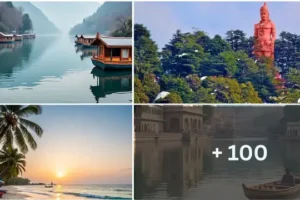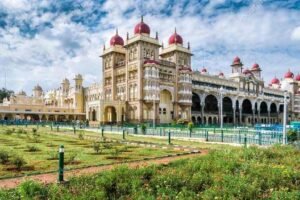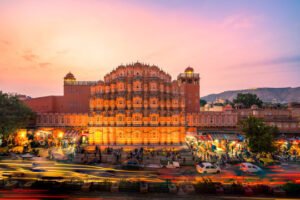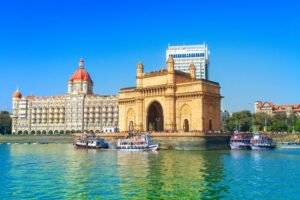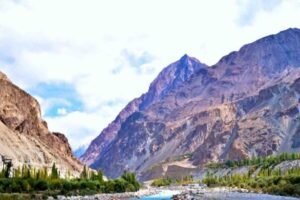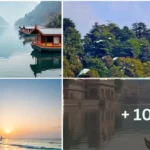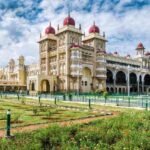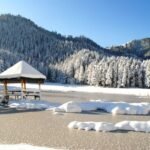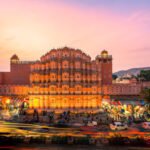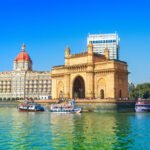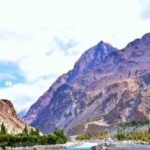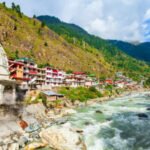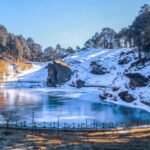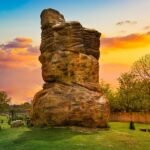Mrikula Mata Temple, Best Places to Visit Nearby, How to Reach in 2025
Mrikula Mata Temple: The Legends With Udaipur Valley Himachal Pradesh is well-known for its mediaeval religious sites. There are numerous temples here, and worshippers have a strong trust in them. Mrikula Mata Temple of Udaipur, located in the district of Lahaul. This sacred shrine’s history is linked to the Dwapara Yuga. Mrkula Devi attracts devotees from all around the world.
The history of the famous Mrikula Mata Temple in Udaipur in the Lahaul valley is linked to the exile period of the Pandavas during the Dwapar Yug (Era). Built at a height of 2623 meters above sea level, this temple is known for its amazing style and wood carvings. Here Mother Kali is worshiped in the eight-armed form of Mahishasura Mardini. This temple is built in Kashmiri Kannauj style. It is said that Mahabali Bhima one day brought a giant tree here and asked Lord Vishwakarma, the architect of the deities, to build a temple here. Vishwakarma built this temple in one day.
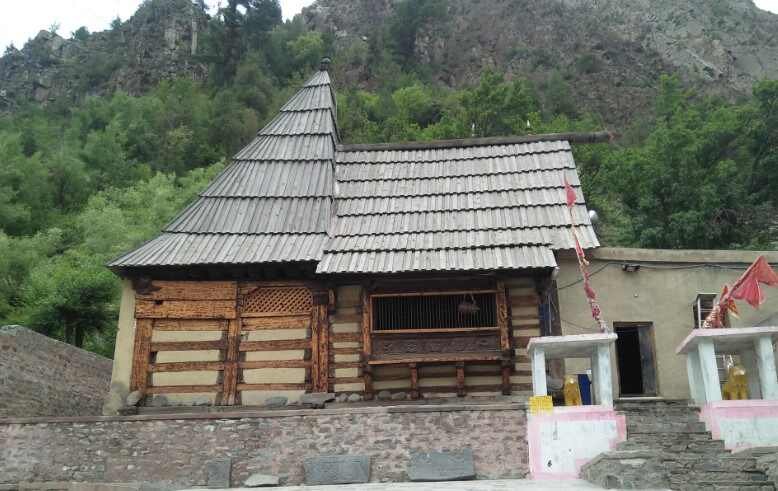
Even today, people are stunned to see the artifacts of Ramayana and Mahabharata made in those days inside the temple. Somewhere Bhishma Pitamah lying on his death bed, somewhere Sagar Manthan, abduction of Sita Maiya, Ashok Vatika, Ganga-Jamuna, eight planets, incarnation of Lord Vishnu, opening of third eye of Lord Shiva, Lord Krishna-Arjun, Draupadi Swayamvar, Abhimanyu’s Chakravyuh. There are wooden images of many gods and goddesses including.
The wooden walls of Mrikula Mata temple are built in Pahari style. It is believed that after killing Mahishasura, Mother Kali had kept a pot full of blood here. This stone is still kept here behind the main idol of Mata Kali. There is a ban on devotees seeing it. People believe that if someone sees this stone even by mistake, he becomes blind.
Cultural Significance of Mrikula Mata
The Mrikula Mata temple in Lahaul Spiti stands as a testament to the rich cultural and artistic heritage of the region.
Architectural Heritage
Mrikula Mata temple true beauty lien within its interior which consists of exquisite deodar wood carvings adorn the walls and pillars, depicting scenes from Ramayana and Mahabharata epics. The intricate architecture resemble those found in the Hadimba temple in Manali, hinting at a shared origin with a skilled 16th century craftsmen. The exterior of temple is simple structure with traditional wooden roof.
Fusion of Styles
The central idol in the temple is a silver statue of Goddess Kali slaying the demon Mahishasura. It showcases a captivating blend of Rajasthani, Kashmiri and Tibetan styles. The nine-panelled roof, with its central lantern design, adds another layer of visual intrigue. Interestingly, four panels depict scenes from Hindu mythology, while another breaks tradition by showcasing the Buddhist concept of the “Assault of Mara,” where Buddha vanquishes desire and death.
Legends and Mystery
The legends around Mrikula Mata revolves around two main stories:
- It’s said that Pandavas themselves built it from a single block of wood during their exile.
- There is a hidden “Khappar” (skull cup) believed to hold the blood of Mahishasura. This sacred object is said to bring misfortune.
These two stories add element of mystery to the temple’s aura. There is also a round stone in the temple which is said to be to heavy to lift but if we use middle finger together with friends we can lift it eaisly.
Best Places to Visit Near Mrikula Mata Temple
Trilokinath Temple
Trilokinath Temple Shrine is so important that is it is considered as most scarred pilgrim thirth next only to Kailash and Mansarover. The uniqueness of the temple lies in the fact that it is the only temple in the whole world where both Hindu and Buddhists pay their reverence to the same deity. The temple is situated in the panoramic Chandra Bhaga valley to the western Himalayas.

The temple is revered by both Hindus and Buddhists. Hindus consider the deity as Lord Shiva, while Buddhists view the same deity as Arya Avalokiteshwar. Tibetan-speaking people refer to the deity as Garja Fagspa. Trilokinath Temple is considered one of the most sacred pilgrimage sites, second only to Mount Kailash and Mansarovar.
Udaipur Town
Udaipur is picturesque town located in Lahaul & Spiti and known for it’s scenic beauty and Buddhists monasteries. It’s the second largest town of Lahaul & Spiti. Situated at an elevation of 2742 meters above the sea level, Udaipur exudes a spiritual solace and natural beauty that captivates travellers. It also serves as the gateway to the Pangi Valley of Chamba district and Miyar Valley of Lahaul & Spiti.

Pangi Valley
Pangi Valley is a hidden gem nestled amidst the Himalayas, the valley boasts stunning natural beauty, with snow capped peaks, luch meadows, and deep gorges carved by Chenab River. Pangi valley is haven for adventures seekers and nature lovers. The valley offers a variety of trekking trails from moderate hikes to challenging expeditions. It’s also home to unique tribal culture.

Miyar Valley
Miyar Valley is remote and scenic valley located in Western Himalayas. It’s part of Lahaul Range , nestled between the Pir Pangal and Zanskar Range. Miyar Valley is a popular destination for trekking and mountaineering , known for its stunning beauty, alpine meadow, glaciers and Miyar river that flows through it. The valley is roughly 75 km long, stretching from Udaipur to Kang La Pass.

How to Reach Mrikula Mata Temple
Some of the important ways to reach Mrikula Mata Temple are:
By Air:
The nearest airport to Mrikula Mata Temple is Kullu Manali Airport (BLR) at Bhuntar, which is 204 kilometers away. From the airport, you can hire a taxi or take a Himachal Pradesh Road Transport Corporation (HRTC) bus to Keylong, the district headquarters. From Keylong, you can again hire a taxi or take an HPRTC bus to Udaipur.
By Train:
The nearest railway station to Mrikula Mata Temple is Pathankot Railway Station (PTK). From Pathankot, you can take a taxi or bus to Manali and then follow the same route as mentioned above for reaching the temple.
By Road:
The most convenient way to reach Mrikula Mata Temple is by road. The temple is well connected to other parts of Himachal Pradesh by a network of roads.
- Route 1: You can take the National Highway 3 (NH3) from Mandi to Kullu and then take a detour towards Lahaul Valley via Atal Tunnel. This route is approximately 245 kilometers and takes around 7 hours to complete.
- Route 2: Another option is to take the Manali-Leh highway Via Rohtang Pass until Keylong and then take a detour towards Udaipur. This route is slightly longer than Route 1, at approximately 260 kilometers, but it offers scenic views of the Himalayas.
Important things to keep in mind:
- Lahaul Valley experiences high snowfall during winters, typically from November to March. During this time, the roads leading to the temple may be closed. The best time to visit Mrikula Mata Temple is from April to October.
- Lahaul Valley is situated at a high altitude. It is advisable to acclimatize yourself for a day or two in Keylong or any other place at a lower altitude before visiting the temple.
- Public transport to Mrikula Mata Temple is limited. Hiring a taxi from Manali or Keylong is the most convenient option.
Best Time to visit Mrikula Mata Temple
Here’s a breakdown of the seasons to help you decide the best time for your visit:
Summer (April – June):
This is the most popular time to visit Mrikula Mata Temple, with pleasant weather and clear skies. However, it can also be the most crowded time.
Monsoon (July – September):
The monsoon season brings occasional rain showers to the region. While the valley turns lush green, landslides can sometimes occur, blocking roads.
Autumn (October – November):
The temperature starts to drop in autumn, and the first signs of snowfall can be seen in the higher reaches. The crowds start to thin out, making it a good time for a peaceful visit.
Winter (December – March):
The Lahaul Valley experiences heavy snowfall during winter, making most roads inaccessible. The temple is likely to be closed during this time.
- Pleasant weather: The summer months in Lahaul Valley experience pleasant weather with comfortable temperatures ranging from 10°C to 25°C. This makes sightseeing and exploring the temple much more enjoyable.
- Open roads: The high mountain passes like Rohtang Pass and Atal Tunnel are typically open during these months, making it easier to reach the temple by road.
- Festivals: The annual three-day Pauri festival, which brings together Hindus and Buddhists, is held in mid-August.
Frequently Asked Question’s
What is the Story of the Mrikula Devi?
Story pf mrikula mata temple revolves around Pandavas that they themselves built it from a single block of wood during their exile. There another tale of a hidden “Khappar” (skull cup) believed to hold the blood of Mahishasura. This sacred object is said to bring misfortune.
Which temple is famous in Lahaul?
Trilokinath Temple is famous in Lahaul.
Who built Mrikula Mata temple in Lahaul?
Pandavas build Mrikula Mata Temple in Lahaul on the time of their exile.
How far is trilokinath temple from Mrikula Mata Temple?
Trilokinath temple is 11.7km from Mrikula Mata Temple.
Where is unliftable rock in Lahaul?
The unliftable rock is present in Mrikula Mata Temple.
